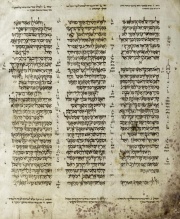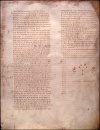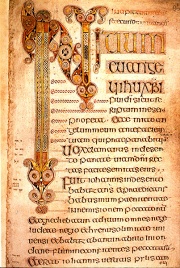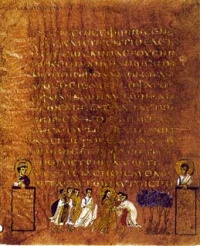Biblical manuscript
From Textus Receptus
A biblical manuscript is any handwritten copy of a portion of the text of the Bible. The word Bible comes from the Greek biblion (book); manuscript comes from Latin manu (hand) and scriptum (written). The original manuscript (the original parchment the author physically wrote on) is called the "autographa." Biblical manuscripts vary in size from tiny scrolls containing individual verses of the Jewish scriptures (see Tefillin) to huge polyglot codices (multi-lingual books) containing both the Hebrew Bible (Tanakh) and the New Testament, as well as extracanonical works.
The study of biblical manuscripts is important because handwritten copies of books can contain errors. The science of textual criticism attempts to reconstruct the original text of books, especially those published prior to the invention of the printing press.
Contents |
Hebrew Bible (or Tanakh) manuscripts

The Aleppo Codex (c. 920 CE) and Leningrad Codex (c. 1008 CE) are the oldest Hebrew language manuscripts of the Tanakh. The 1947 find at Qumran of the Dead Sea scrolls pushed the manuscript history of the Tanakh back a millennium from the two earliest complete codices (see Tanakh at Qumran). Before this discovery, the earliest extant manuscripts of the Old Testament were in Greek in manuscripts such as Codex Vaticanus and Codex Sinaiticus. Out of the roughly 800 manuscripts found at Qumran, 220 are from the Tanakh. Every book of the Tanakh is represented except for the Book of Esther; however, most are fragmentary. Notably, there are two scrolls of the Book of Isaiah, one complete (1QIsa), and one around 75% complete (1QIsb). These manuscripts generally date between 150 BCE to 70 CE.[]
Ancient Jewish scribes developed many practices to protect copies of their scriptures from error. Their methods resulted in insignificant variations among texts arising at an average rate of just under one consonant in every 1,500.[]
Extant Tanakh manuscripts
New Testament manuscripts
The New Testament has been preserved in more manuscripts than any other ancient work, having over 5,800 complete or fragmented Greek manuscripts, 10,000 Latin manuscripts and 9,300 manuscripts in various other ancient languages including Syriac, Slavic, Gothic, Ethiopic, Coptic and Armenian. The dates of these manuscripts range from circa 125 (the John Ryland's manuscript, P52; oldest copy of John fragments) to the introduction of printing in Germany in the 15th century. The vast majority of these manuscripts date after the 10th century. Because there are more New Testament manuscripts than any other ancient writing (e.g., we only have 10 copies of Julius Caesar's 'The Gallic Wars'), Christian apologists such as Josh Mcdowell and Norman Geisler assert that by literary standards, the New Testament is a reliable witness to the original text.[][][] Textual scholar Bart Ehrman disagrees: "It is true, of course, that the New Testament is abundantly attested in the manuscripts produced through the ages, but most of these manuscripts are many centuries removed from the originals, and none of them perfectly accurate. They all contain mistakes - altogether many thousands of mistakes. It is not an easy task to reconstruct the original words of the New Testament..."[] In reference to the textual evidence for the New Testament, Bruce Metzger wrote "In evaluating the significance of these statistics...one should consider, by way of contrast, the number of manuscripts which preserve the text of the ancient classics. Homer's Iliad...is preserved by 457 papyri, 2 uncial manuscripts, and 188 minuscule manuscripts. Among the tragedians the witnesses to Euripides are the most abundant; his extant works are preserved in 54 papyri and 276 parchment manuscripts, almost all of the later dating from the Byzantine period...the time between the composition of the books of the New Testament and the earliest extant copies is relatively brief. Instead of the lapse of a millennium or more, as is the case of not a few classical authors, several papyrus manuscripts of portions of the New Testament are extant which were copies within a century or so after the composition of the original documents."[] []
Every year, several New Testament manuscripts handwritten in the original Greek format are discovered. The latest substantial find was in 2008, when 47 new manuscripts were discovered in Albania; at least 17 of them unknown to Western scholars.[]
When comparing one manuscript to another, with the exception of the smallest fragments, no two copies agree completely throughout. Note, however, that a single difference prevents agreement. There has been an estimate of between 400,000 variations among all these manuscripts (from the 2nd to 15th century) which is more than there are words in the New Testament. This means less significant than may appear since it is a comparison across linguistic boundaries. More important estimates focus on comparing texts within languages. Those variations are considerably fewer. The vast majority of these are accidental errors made by scribes, and are easily identified as such: an omitted word, a duplicate line, a misspelling, a rearrangement of words. Some variations involve apparently intentional changes, which often make more difficult a determination of whether they were corrections from better exemplars, harmonizations between readings, or ideologically motivated.[] Palaeography is the study of ancient writing, and textual criticism is the study of manuscripts in order to reconstruct a probable original text.
The difficulty in all of this, though, is in where the manuscripts are coming from. Often, especially in monasteries, a manuscript cache is little more than a former manuscript recycling center where imperfect and incomplete copies of manuscripts were stored while the monastery or scriptorium decided what to do with them.[] There were several options. The first was to simply "wash" the manuscript and reuse it. This was very common in the ancient world and even up into the Middle Ages; such reused manuscripts are called palimpsests. The most famous palimpsest is probably the Archimedes Palimpsest. If this was not done within a short period of time after the papyri was made, then washing it was less likely since the papyri might deteriorate and thus be unusable. When washing was no longer an option, then the second and third choices were either burning (since they contained the words of Christ and the apostles, prophets, and saints, and were thought to have had a higher level of sanctity than secular literature []). Burning them was considered more reverent than simply throwing them into the nearby garbage pit, although that was not unheard of as in the case of Oxyrhynchus 840). The third option was simply to leave them in what has become known as a manuscript gravesite. When scholars come across manuscript caches, for example that at Saint Catherine's Monastery in the Sinai (source of the Codex Sinaiticus), or Saint Sabbas Monastery outside Bethlehem, they are not finding libraries, but storehouses of rejected texts [] Sometimes, oddly, kept in boxes or back shelves in libraries due to space constraints) which are unacceptable because of their scribal errors and contain corrections inside the lines [] possibly evidence of scribes at the monastery were comparing it to what had to have been a master text. In addition, texts thought complete and correct but which had deteriorated due to heavy usage and/or had missing folios would also be placed in these caches. Once in a cache, insects and humidity would often contribute to the continued deterioration of the documents.[]
Complete and correctly copied texts would usually be immediately placed in use and thus usually wear out fairly quickly which would require repeated recopying. Further, because manuscript copying was highly costly when it required a scribe's attention for extended periods, a manuscript might only be made when commissioned, in which case the size of the parchment, script used, any illustrations (thus raising the effective cost), whether it was one book or a collection of several, etc. would be determined by the one commissioning the work. The idea of stocking extra copies would probably have been considered at best wasteful and unnecessary since the form and a manuscript was more often than not customized to the aesthetic tastes of the buyer. This is part of the reason why scholars are more likely to find incomplete, and at times conflicting, segments of manuscripts rather than complete and largely consistent works.[]
Distribution of Greek manuscripts by century []
| New Testament Manuscripts | Lectionaries | ||||
| Century | Papyri | Uncials | Minuscules | Uncials | Minuscules |
| 2nd | 2 | - | - | - | - |
| 2nd/3rd | 5 | 1 | - | - | - |
| 3rd | 28 | 2 | - | - | - |
| 3rd/4th | 8 | 2 | - | - | - |
| 4th | 14 | 14 | - | 1 | - |
| 4th/5th | 8 | 8 | - | - | - |
| 5th | 2 | 36 | - | 1 | - |
| 5th/6th | 4 | 10 | - | - | - |
| 6th | 7 | 51 | - | 3 | - |
| 6th/7th | 5 | 5 | - | 1 | - |
| 7th | 8 | 28 | - | 4 | - |
| 7th/8th | 3 | 4 | - | - | - |
| 8th | 2 | 29 | - | 22 | - |
| 8th/9th | - | 4 | - | 5 | - |
| 9th | - | 53 | 13 | 113 | 5 |
| 9th/10th | - | 1 | 4 | - | 1 |
| 10th | - | 17 | 124 | 108 | 38 |
| 10th/11th | - | 3 | 8 | 3 | 4 |
| 11th | - | 1 | 429 | 15 | 227 |
| 11th/12th | - | - | 33 | - | 13 |
| 12th | - | - | 555 | 6 | 486 |
| 12th/13th | - | - | 26 | - | 17 |
| 13th | - | - | 547 | 4 | 394 |
| 13th/14th | - | - | 28 | - | 17 |
| 14th | - | - | 511 | - | 308 |
| 14th/15th | - | - | 8 | - | 2 |
| 15th | - | - | 241 | - | 171 |
| 15th/16th | - | - | 4 | - | 2 |
| 16th | - | - | 136 | - | 194 |
Transmission
The task of copying manuscripts was generally done by scribes who were trained professionals in the arts of writing and bookmaking. Some manuscripts were also proofread, and scholars closely examining a text can sometimes find the original and corrections found in certain manuscripts. In the 6th century, a special room devoted to the practice of manuscript writing and illumination called the scriptorium came into use, typically inside medieval European monasteries. Sometimes a group of scribes would make copies at the same time as one individual read from the text.[]
Manuscript construction
An important issue with manuscripts is preservation. The earliest New Testament manuscripts were written on papyrus, made from a reed that grew abundantly in the Egyptian Nile Delta. This tradition continued as late as the 8th century.[] Papyrus eventually becomes brittle and deteriorates with age. The dry climate of Egypt allowed some papyrus manuscripts to be partially preserved, but, with the exception of P77, no New Testament papyrus manuscript is complete; many consist only of a single fragmented page.[] However, beginning in the 4th century, parchment (also called vellum) began to be a common medium for New Testament manuscripts.[] It wasn't until the 12th century that paper (made from cotton or plant fibers), which was invented in 1st century China, began to gain popularity in biblical manuscripts.[]
Of the 476 non-Christian manuscripts dated to the 2nd century, 97% of the manuscripts are in the form of scrolls; however, the 8 Christian manuscripts are codices. In fact, most New Testament manuscripts are codices. The adaptation of the codex form in non-Christian text did not become dominant until the 4th and 5th centuries, showing a preference for that form amongst early Christians.[] The considerable length of some New Testament books (such as the Pauline epistles), and the New Testament itself, was not suited to the limited space available on a single scroll; in contrast a codex could be expanded to hundreds of pages.
Script and other features
The handwriting found in New Testament manuscripts varies. One way of classifying handwriting is by formality: book-hand vs. cursive. More formal, literary Greek works were often written in a distinctive style of even, capital letters called book-hand. Less formal writing consisted of cursive letters which could be written quickly. Another way of dividing handwriting is between uncial (or majuscule) and minuscule. The uncial letters were a consistent height between the baseline and the cap height, while the minuscule letters had ascenders and descenders that moved past the baseline and cap height. Generally speaking, the majuscules are earlier than the minuscules, with a dividing line roughly in the 11th century.[]
The earliest manuscripts had hardly, if any, punctuation or breathing marks. The manuscripts also lacked word spacing, so words, sentences, and paragraphs would be a continuous string of letters (scriptio continua), often with line breaks in the middle of words. Bookmaking was an expensive endeavor, and one way to reduce the number of pages used was to save space. Another method employed was to abbreviate frequent words, such as the nomina sacra. Yet another method involved the palimpsest, a manuscript which recycled an older manuscript. Scholars using careful examination can sometimes determine what was originally written on the material of a document before it was erased to make way for a new text (for example Codex Ephraemi Rescriptus and the Sinaitic Palimpsest).
The original New Testament books did not have titles, section headings, or verse and chapter divisions. These were developed over the years as "helps for readers". The Ammonian Sections were an early system of division written in the margin of many manuscripts. The Eusebian Canons was a series of tables that grouped parallel stories among the gospels. After 400 were used κεφαλαια.
Manuscripts became more ornate over the centuries, which developed into a rich illuminated manuscript tradition, including the famous Irish Gospel Books, the Book of Kells and the Book of Durrow.
Cataloging
Desiderius Erasmus compiled the first printed edition of the Greek New Testament in 1516, basing his work on several manuscripts because he did not have a single complete work and because each manuscript had small errors. In the 18th century, [[Johann
| Manuscript | Examples | Language | Date of Composition | Oldest Copy |
|---|---|---|---|---|
| Dead Sea Scrolls | Tanakh at Qumran | Hebrew, Paleo Hebrew and Greek(Septuagint) | c. 150 BCE - 70 CE | c. 150 BCE - 70 CE |
| Septuagint | Codex Vaticanus, Codex Sinaiticus and other earlier papyri | Greek | 300-100 BCE | 2nd century BCE(fragments) 4th century CE(complete) |
| Peshitta | Syriac | early 5th century CE | ||
| Vulgate | Latin | early 5th century CE | ||
| Masoretic | Aleppo Codex, Leningrad Codex and other incomplete mss | Hebrew | ca. 100 CE | 10th century CE |
| Samaritan Pentateuch | Samaritan alphabet | 200-100 BCE | Oldest extant mss c.11th century CE, oldest mss available to scholars 16th century CE | |
| Targum | Aramaic | 500-1000 CE | 5th century CE | |



